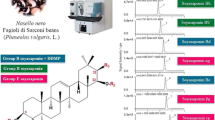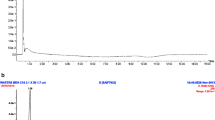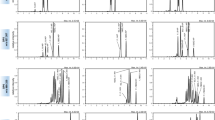Abstract
Major soyasaponins, i.e., soyasaponins I, V, βg, and αg from traditional Fagioli di Sarconi beans (Phaseolus vulgaris L., ecotype Tabacchino), were analyzed by reversed-phase liquid chromatography–mass spectrometry (MS) using high-resolution Fourier transform ion cyclotron resonance (FTICR) MS on electrospray ionization in positive-ion mode. Fagioli di Sarconi beans are protected by the European Union [Commission Regulation (EC) No 1263/96] with the mark PGI (for “Protected Geographical Indication”), and are cultivated in Basilicata (southern Italy). Protonated adducts of soyasaponins I, V, βg, and αg were observed at m/z 943.5262, 959.5213, 1069.5583, and 1085.5534, respectively. Gas-phase dissociation of soyasaponins by infrared multiphoton dissociation FTICR MS was performed using a CO2 laser source at a wavelength of 10.6 μm. Most of the fragment ions were identified unambiguously by using the high-resolution and accurate mass value provided by the FTICR mass spectrometer. All soyasaponins exhibit a sequential and neutral loss of sugar moieties at relatively short irradiation times (i.e., less than 50 ms). When the pulse length was increased, a more pronounced fragmentation occurred, with several signals in the lower part of the mass spectrum. In the case of soyasaponins βg and αg, the occurrence of the conjugated product ion at m/z 127.0389 ([C6H6O3 + H]+, 2,3-dihydro-2,5-dihydroxy-6-methyl-4H-pyran-4-one) was evidenced. Coupling reversed-phase liquid chromatography with high-performance FTICR MS in combination with infrared multiphoton dissociation tandem MS proved to be very promising for the structural characterization of soyasaponins, and is also suitable for the rapid and accurate structural investigation of other saponins.

Representative Infrared Multiphoton Dissociation (IRMPD)–FTICR MS spectra of main group B saponins in Fagioli di Sarconi beans





Similar content being viewed by others
References
Vincken JP, Heng L, de Groot A, Gruppen H (2007) Saponins, classification and occurrence in the plant kingdom. Phytochemistry 68:275–297
Sparg SG, Light ME, van Staden J (2004) Biological activities and distribution of plant saponins. J Ethnopharmacol 94:219–243
Osbourn A, Goss RJM, Field RA (2011) The saponins – polar isoprenoids with important and diverse biological activities. Nat Prod Rep 28:1261–1268
Hu J, Lee SO, Hendrich S, Murphy PA (2002) Quantification of the group B soyasaponins by high-performance liquid chromatography. J Agric Food Chem 50:2587–2594
Sagratini G, Zuo Y, Caprioli G, Cristalli G, Giardinà D, Maggi F, Molin L, Ricciutelli M, Traldi P, Vittori S (2009) Quantification of soyasaponins I and βg in Italian lentil seeds by solid-phase extraction (SPE) and high-performance liquid chromatography-mass spectrometry (HPLC-MS). J Agric Food Chem 51:11226–11233
Romani A, Vignolini P, Falvino MA, Heimler D (2013) Polyphenol content and antiradical activity of “Sarconi” beans (Phaseolus vulgaris L.) ecotype. Ital J Food Sci 25:322–329
Hubert J, Berger M, Dayde J (2005) Use of a simplified HPLC-UV analysis for soyasaponin B determination: study of saponin and isoflavone variability in soybean cultivars and soy-based health food products. J Agric Food Chem 53:3923–3930
Decroos K, Vincken JP, Heng L, Bakker R, Gruppen H, Verstraete W (2005) Simultaneous quantification of differently glycosylated, acetylated, and 2,3-dihydro-2,5-dihydroxy-6-methyl-4H-pyran-4-one-conjugated soyasaponins using reversed-phase high-performance liquid chromatography with evaporative light scattering detection. J Chromatogr A 1072:185–19
Lin J, Wang C (2004) An analytical method for soy saponins by HPLC/ELSD. J Food Sci 69:456–462
Dalluge JJ, Eliason E, Frazer S (2003) Simultaneous identification of soyasaponins and isoflavones and quantification of soyasaponin Bb in soy products, using liquid chromatography/electrospray ionization-mass spectrometry. J Agric Food Chem 51:3520–3524
Jin M, Yang Y, Su B, Ren Q (2007) Determination of soyasaponins Ba and Bb in human serum by high-performance liquid chromatography coupled with electrospray ionization tandem mass spectrometry. J Chromatogr B 846:169–175
Li B, Abliz Z, Fu G, Tang M, Yu S (2005) Characteristic fragmentation behavior of some glucuronide-type triterpenoid saponins using electrospray ionization tandem mass spectrometry. Rapid Commun Mass Spectrom 19:381–390
Lee MR, Chen CM, Hwang BH, Hsu LM (1999) Analysis of saponins from black bean by electrospray ionization and fast atom bombardment tandem mass spectrometry. J Mass Spectrom 34:804–812
Berhow MA, Kong S, Vermillion KE, Duval SM (2006) Complete quantification of group A and group B soyasaponins in soybeans. J Agric Food Chem 54:2035–2044
Woodlin RL, Bomse DS, Beauchamp JL (1978) Multiphoton dissociation of molecules with low power continuous wave infrared laser radiation. J Am Chem Soc 100:3248–3250
Little DP, Speir JP, Senko MW, O’Connor PB, McLafferty FW (1994) Infrared multiphoton dissociation of large multiply-charged ions for biomolecule sequencing. Anal Chem 66:2809–2815
Bianco G, Labella C, Pepe A, Cataldi TRI (2013) Scrambling of autoinducing precursor-peptides investigated by infrared multiphoton dissociation with electrospray ionization and Fourier-transform ion cyclotron resonance mass spectrometry. Anal Bioanal Chem 5:1721–1732
European Commission (1996) Commission Regulation (EC) No 1263/96 of 1 July 1996 supplementing the Annex to Regulation (EC) No 1107/96 on the registration of geographical indications and designations of origin under the procedure laid down in Article 17 of Regulation (EEC) No 2081/92. Off J Eur Communities L 163:19–21
Zhang W, Ping Teng S, Popovich DG (2009) Generation of group B soyasaponins I and III by hydrolysis. J Agric Food Chem 57:3620–3625
Jin M, Yang Y, Su B, Ren Q (2006) Rapid quantification and characterization of soyasaponins by high-performance liquid chromatography coupled with electrospray mass spectrometry. J Chromatogr A 1108:31–37
Bianco G, Lelario F, Battista GF, Bufo SA, Cataldi T (2012) Identification of glucosinolates in capers by LC-ESI using a hybrid linear ion trap with Fourier-transform ion cyclotron resonance mass spectrometry (LC-ESI-LTQ-FTICR-MS) and infrared multiphoton dissociation. J Mass Spectrom 47:1160–1169
Zhang W, Popovich DG (2009) Chemical and biological characterization of oleanane triterpenoids from Soy. Molecules 14:2959–2975
Curl CL, Price KR, Fenwick GR (1988) Isolation and structural elucidation of a new saponin (‘Soyasaponin V’) from haricot bean (Phaseolus vulgaris L.). J Sci Food Agric 43:101–107
Yoshiki Y, Jin-Hyeong K, Okubo K (1994) Saponins conjugated with 2,3-dihydro-2,5-dihydroxy-6-methyl-4H-pyran-4-one from Phaseolus coccineus. Phytochemistry 36:1009–1012
Laskin J, Futrell JH (2004) Activation of large ions in FT-ICR mass spectrometry. Mass Spectrom Rev 24:135–167
Sleno L, Volmer DA (2004) Ion activation methods for tandem mass spectrometry. J Mass Spectrom 39:1091–1112
Domon B, Costello CE (1988) A systematic nomenclature for carbohydrate fragmentations in FAB-MS/MS spectra of glycoconjugates. Glycoconj J 5:397–409
Acknowledgments
This work was performed by using the instrumental facilities of the CIGAS Center supported by the EU (project no. 2915/12), Regione Basilicata, and Università degli Studi della Basilicata.
Author information
Authors and Affiliations
Corresponding author
Additional information
Published in the topical collection High-Resolution Mass Spectrometry in Food and Environmental Analysis with guest editor Aldo Laganà.
Electronic supplementary material
Below is the link to the electronic supplementary material.
ESM 1
(PDF 53 kb)
Rights and permissions
About this article
Cite this article
Bianco, G., Buchicchio, A. & Cataldi, T.R.I. Structural characterization of major soyasaponins in traditional cultivars of Fagioli di Sarconi beans investigated by high-resolution tandem mass spectrometry. Anal Bioanal Chem 407, 6381–6389 (2015). https://doi.org/10.1007/s00216-015-8810-3
Received:
Revised:
Accepted:
Published:
Issue Date:
DOI: https://doi.org/10.1007/s00216-015-8810-3




